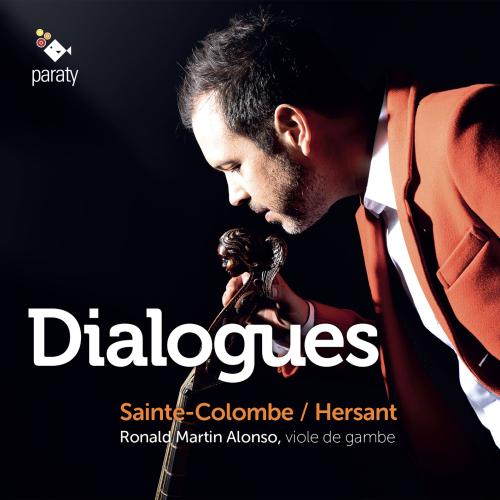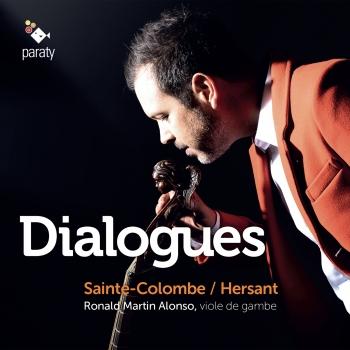
Dialogues Ronald Martin Alonso
Album Info
Album Veröffentlichung:
2020
HRA-Veröffentlichung:
25.09.2020
Label: Paraty
Genre: Classical
Subgenre: Chamber Music
Interpret: Ronald Martin Alonso
Komponist: Philippe Hersant (1948), Monsieur de Sainte-Colombe (1640-1713)
Das Album enthält Albumcover Booklet (PDF)
- Monsieur de Sainte-Colombe (1640 - 1700): Suite pour viole en Sol Mineur:
- 1 Suite pour viole en Sol Mineur: I. Prélude 02:15
- 2 Suite pour viole en Sol Mineur: II. Pianelle 01:49
- 3 Suite pour viole en Sol Mineur: III. Sarabande 02:06
- 4 Suite pour viole en Sol Mineur: IV. Gigue 02:02
- Philippe Hersant (b. 1948): Le chemin de Jérusalem:
- 5 Le chemin de Jérusalem: Mouvement 1 03:14
- 6 Le chemin de Jérusalem: Mouvement 2 01:46
- 7 Le chemin de Jérusalem: Mouvement 3 03:38
- Monsieur de Sainte-Colombe: Suite pour viole en Do Majeur:
- 8 Suite pour viole en Do Majeur: I. Allemande 02:30
- 9 Suite pour viole en Do Majeur: II. Courante 01:58
- 10 Suite pour viole en Do Majeur: III. Sarabande 03:24
- 11 Suite pour viole en Do Majeur: IV. Gigue 01:08
- 12 Suite pour viole en Do Majeur: V. Sarabande en passacaille 02:40
- 13 Suite pour viole en Do Majeur: VI. Gigue 01:53
- 14 Suite pour viole en Do Majeur: VII. Menuet 00:44
- 15 Suite pour viole en Do Majeur: VIII. Menuet 01:21
- 16 Suite pour viole en Do Majeur: IX. Chaconne 04:46
- Philippe Hersant: Pascolas:
- 17 Pascolas: Mouvement 1 02:48
- 18 Pascolas: Mouvement 2 02:17
- 19 Pascolas: Mouvement 3 01:08
- Monsieur de Sainte-Colombe: Suite pour viole en Ré Mineur:
- 20 Suite pour viole en Ré Mineur: I. Prélude 02:38
- 21 Suite pour viole en Ré Mineur: II. Allemande 03:09
- 22 Suite pour viole en Ré Mineur: III. Courante 02:15
- 23 Suite pour viole en Ré Mineur: IV. Sarabande 02:25
- 24 Suite pour viole en Ré Mineur: V. Double de la Sarabande 01:51
- 25 Suite pour viole en Ré Mineur: VI. Gigue 01:50
- 26 Suite pour viole en Ré Mineur: VII. Chaconne 03:12
Info zu Dialogues
The solo pieces by Monsieur de Sainte-Colombe presented here were written around 1690 and are part of a manuscript included in the archives of the municipal library in Tournus, Burgundy. Hence its name: the ‘Tournus Manuscript’. The first modern edition of the manuscript was published in 2013 by Edition Güntersberg, prepared by Herausgegeben von Günter and Leonore von Zadow. Until then, only a facsimile edition by Minkoff had been published, one which is long since out of print. I came across the pieces quite by accident while searching through the music shops that populate the Rue de Rome in Paris. I was straight away fascinated by the richness and wildness of the writing which struck me as more akin to improvisations rich with fantasy. The freedom of the writing leaves ample liberty to the performer to construct the rhetoric and development of each phrase, to decide on the appropriate rhythmic proportions for each dance, to choose the tempo at which the notes should be played and to consider which moments to accentuate and stress. Today, a few composers take inspiration from Sainte-Colombe’s heritage to give new life to the viola da gamba. The French composer Philippe Hersant, born in Rome in 1948, has written a number of pieces for solo viola da gamba, including ‘Le chemin de Jérusalem’ (The Road to Jerusalem – 2003), as well as using the viola da gamba as a solo instrument with vocal ensemble in Psalm 130, Aus Tiefer Not (1994), Stabat Mater (2002), Falling Star (2005), Clair Obscur (Light-Dark 2008) or in combination with other baroque instruments (lutes, theorbo, cornett, baroque violins), such as the Cantique des trois enfants dans la fournaise (Song of the Three Children in the Furnace, 2014) for which he was consecrated composer of the year for the third time in the annual French classical music awards in 2016. In this recording I have chosen to pair two composers, both of whose work is of profound importance to me, in a dialogue that transports us into their respective fantasy universes. They cohabit, influence and exchange with each other in such a way that the notion of time disappears entirely. This selection invites us into a journey where music dialogues wordlessly and where the sound of the viole and the emotions it elicits combine to narrate a story, to awaken intense emotions and send us from one extreme of emotion to another, from profound sadness to ecstatic joy. The viola da gamba: an instrument that has come back to life and which like a mirror reflects the past into the present.
Ronald Martin Alonso, viola da gamba
Ronald Martin Alonso
Born in Cuba in 1980, The Franco-Cuban viola da gamba player Ronald Martin Alonso lives in Paris, France. His first forays into the world of early music were with the Ars Longa ensemble, (Direction: Teresa Paz), which has performed in many of Europe’s leading festivals alongside leading conductors such as Claudio Abbado and Gabriel Garrido. His recordings from the Latin American baroque repertoire have been distinguished by the specialist press, including the Diapason d’Or, Choc du Monde de la Musique, ffff Télérama and a score of ten from Répertoire. With the Stravaganza ensemble, in 2011 he was awarded the Critics and Media prize, as well as third prize in the International Chamber Music Competition Premio Bonporti in Roveretto, Italy, the Graaf Unico Wilhelm prize at the Van Wassnaer Competition in Amsterdam (Netherlands), and in 2012 the F.J. Aumann prize at the H.I.F. Biber International Competition in Austria. In 2011 he founded the Vedado Musica Ensemble to produce musical projects centered on the viola da gamba melting baroque and contemporary musique. In 2015 he made his first solo recording, Les Folies Humaines, comprising works by Marin Marais. He regularly performs with leading ensembles, including La Cappella Mediterranea (Leonardo GarcíaAlarcón), Il Festino (Manuel de Grange), Fuoco e Cenere (Jay Bernfeld), Les Traversées Baroques (Etienne Meyer), Stravaganza (Thomas Soltani), Desmarest (Ronan Khalil), La Chapelle Rhénane (Benoît Haller), les Métaboles (Léo Warinsky) at leading festivals in Europe and Latin America like the Concertgebouw Amsterdam, Dutch National Opera Amsterdam, Opéra National de Paris, Opéra Royal de Versailles, Auditorium de Radio France, Auditorium National de Bordeaux, Festival d’Ambronay, Festival de la Chaise-Dieu, Festival de Sablé, Teatro Colón in Buenos Aires, Opera de Rio de Janeiro, just to mention some of them. He is graduate in classical guitar and double-bass from the Havana Conservatory of Music. Recipient of a bursary from the Centre International des Chemins du Baroque, in 2007 he was awarded his Specialist Diploma in Viola da Gamba after studying with Rebeka Ruso and his Diploma in Chamber Music after studying with Martin Gester at the Regional Conservatory of Music in Strasbourg, France. Three years later, in 2010, after studying with Ariane Maurette at the Paris Region Conservatory of Music, he was granted his Masters in Music (Viola da Gamba) on a unanimous decision and with the compliments of the jury. He has participated in several master classes and academies run by Jordi Savall and Christophe Coin at the Royal College of Music in London, with Marianne Müller at the Paris Region Conservatory, at the Périgord Noir Baroque Academy (M. Laplénie), the European Baroque Academy at Ambronay (M. Gester) and the Montfrin Baroque Academy (G. Garrido).
Booklet für Dialogues










